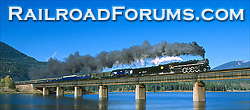Railroadforums.com is a free online
Railroad Discussion Forum and
Railroad Photo Gallery for railroaders, railfans, model railroaders and anyone else who is interested in railroads. We cover a wide variety of topics, including freight trains, passenger and commuter railroads, rail news and information, tourist railroads, railway museums and railroad history.
I still want to know one thing--how long is a typical service life for a locomotive (steam or diesel) before it is withdrawn or scrapped? 20 years? 30? Obviously service lives can get as high as 40 or 50, considering all the 40- and 50-year-old Geeps and SD's that are used in yard service because the single-purpose yard engine has become a thing of the past, some in original condition and others in rebuilt form.
Are not some of the geeps being rebuilt now to be more powerful and eco friendly
Are not some of the geeps being rebuilt now to be more powerful and eco friendly
That is true.
However, back to the question on hand, I've always assumed the "average" to be 30, but then some classic 4-4-0, 2-6-0, 4-6-0 and 2-8-0 locomotives from the late 19th/early 20th century had lasted until the 1950's. I guess it all depends on the railroad company's system and whether the engines can be relegated to secondary or branchline duties.
In my reading, it seems much depends on how good a machine it is to begin with. One good example are some of those monster articulateds (don't press me for models right now; my book is packed away!) which had such bad wheel slip that the power generated at the cylinder wasn't reliably applied to moving the consist forward. Machines like that usually didn't make it to 10 years; often were scrapped much sooner, or parts put on other locos.
I've read of other machines, electrics, built in the 20s or 30s still in use to this day! I greatly admire this...both for the locomotive design and the wisdom of keeping a working machine on the job.
The Pennsylvania T1 was one such articulated. Just another reason steam was scrapped for the Diesels, I guess. Ease & cost of repairs played a great deal in locomotive life. Many Baldwins had their prime movers replaced with new VO models, ALCO or EMD prime movers. This would add may more years to the life of a locomotive. On top if that, several businesses have cropped up that rebuild retired locomotives.
RailroadForums.com is a participant in the Amazon Services LLC Associates Program, an affiliate advertising program designed to provide a means for sites to earn advertising fees by advertising and linking to amazon.com
RailroadBookstore.com - An online railroad bookstore featuring a curated selection of new and used railroad books. Railroad pictorials, railroad history, steam locomotives, passenger trains, modern railroading. Hundreds of titles available, most at discount prices! We also have a video and children's book section.
ModelRailroadBookstore.com - An online model railroad bookstore featuring a curated selection of new and used books. Layout design, track plans, scenery and structure building, wiring, DCC, Tinplate, Toy Trains, Price Guides and more.
|
Affiliate Disclosure: We may receive a commision from some of the links and ads shown on this website
(Learn More Here)

